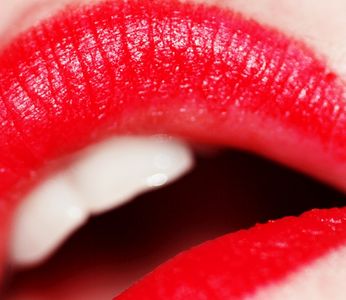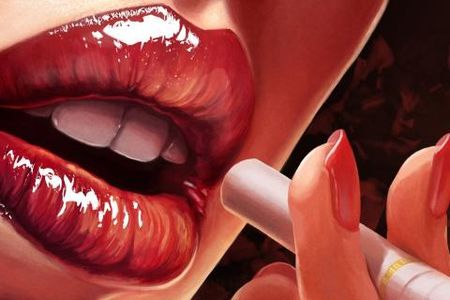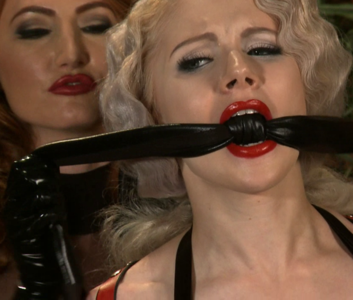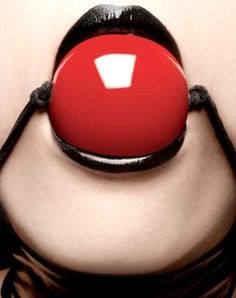Lipstick
Lipstick is a cosmetic product containing pigments, oils, waxes, and emollients that apply color, texture, and protection to the lips.
Many colors and types of lipstick exist. As with most other types of makeup, lipstick is typically, but not exclusively, worn by women. The use of lipstick dates back to medieval times. Some lipsticks are also lip balms, to add color and hydration.
- Lipstick images
Lipstick trends
Throughout the early 20th century, lipstick came in a limited number of shades.
Dark red was one of the most popular shade throughout the 19th and 20th century. Dark red lipstick was popular in the 1920s. Flappers wore lipstick to symbolize their independence. Lipstick was worn around the lips to form a "Cupid's bow," inspired by actress Clara Bow. At that time, it was acceptable to apply lipstick in public and during lunch, but never at dinner.
In the early 1930s, Elizabeth Arden began to introduce different lipstick colors. She inspired other companies to create a variety of lipstick shades. In the 1930s, lipstick was seen as symbol of adult sexuality. Teenage girls believed that lipstick was a symbol of womanhood. Adults saw it as an act of rebellion. Many Americans, especially immigrants, did not accept teenage girls wearing lipstick. A study in 1937 survey revealed that over 50% of teenage girls fought with their parents over lipstick.
In the mid-1940s, several teen books and magazines stressed that men prefer a natural look over a made-up look. Books and magazines also warned girls that wearing cosmetics could ruin their chances of popularity and a career. The implication of these articles was that lipstick and rouge were for teen girls who acted very provocatively with men. Despite the increased use of cosmetics, it was still associated with prostitution. Teen girls were discouraged from wearing cosmetics for fear that they would be mistaken for "loose" girls or prostitutes.
By the 1950s, movie actresses Marilyn Monroe and Elizabeth Taylor helped bring back dark red lips. A 1951 survey revealed that two-thirds of teenage girls wore lipstick.
In 1950 chemist Hazel Bishop formed a company, Hazel Bishop Inc., to promote her invention of long-lasting, non-smearing 'kissproof' lipstick ("stays on you... not on him"), which quickly gained acceptance. At the end of the 1950s, a cosmetic company named Gala introduced pale shimmery lipstick. Later, Max Factor created a popular lipstick color called Strawberry Meringue. Lipstick manufacturers began creating lipsticks in lavender, pale pink, white, and peach. Since parents generally frowned on teen girls wearing red lipstick, some teen girls began wearing pink and peach lipsticks, which became a trend. White or nearly white lipstick was popular in the 1960s.[22] Rock groups such as the Ronettes and the Shirelles popularized white lipstick. Girls would apply white lipstick over pink lipstick or place under-eye concealer on their lips. During that time, many lipsticks were either matte, sheer, or slightly shiny. In the 1960s, lipstick was associated with femininity. Women who did not wear lipstick were suspected of mental illness or lesbianism.
In the 1970s, a number of cosmetic companies introduced lipsticks in more unusual colors such as iridescent light blue (Kanebo), frosted lime green (Conga Lime by Revlon), and silver sparkled navy blue (Metallic Grandma by Biba). M*A*C cosmetics continues to release limited edition and highly collectible lipsticks in a wide range of colors and finishes, including unusual hues of violets, blues, and greens.
Black lipstick became popular in the late 1970s and into the 1990s. In the 1950s, black lipstick had been worn by actresses starring in horror films. It became popular again due in part to punk and goth subcultures.
In the mid-1980s, so-called mood lipstick were sold to adults by mainstream cosmetic companies. This type of lipstick changes colors after it is applied, based on changes in skin's pH that supposedly reflect the wearer's mood. Previously these had been available as little girls' play makeup. They had another resurgence in the very early 21st century, offered by inexpensive as well as more exclusive cosmetic lines, and color changing chemicals also appeared in lip gloss, such as Smashbox O-Gloss, and blush, such as Stila Custom Color Blush.
In the 1990s, lipstick colors became semi-matte. Shades of brown were very popular. These shades were inspired by several shows such as "Friends". In the late 1990s and into the 21st century, pearl shades became very popular. Lipsticks were no longer matte or semi-matte, they were shiny and contained several interference pearls.
In 2012, bright bold lip colors became trendy again with saturated colors such as hot pink, neon, and orange.
In 2014 and early 2015 nude lipsticks were coming up to be incredibly popular. These lipsticks follow the general trend where "less is more". Examples of non-entities promoting this trend are Kim Kardashian and Kylie Jenner.
Queer Significance
A lipstick lesbian is a female who is typically attracted to other females who are butchy and masculine, but she still remains feminine and has a “girly" identity. The term lipstick lesbian became popular by writer Deborah Bergman, a reporter for The Los Angeles Times. While running the LA Times, she created Lesbian News. "The Lesbian News was in good part responsible for popularizing the ‘lipstick lesbian’ who had been born in L.A. and has more recently been made famous worldwide through the television series, The L Word" (Faderman 275).
See also [ Lipstick fetishism ]
Chat rooms • What links here • Copyright info • Contact information • Category:Root



